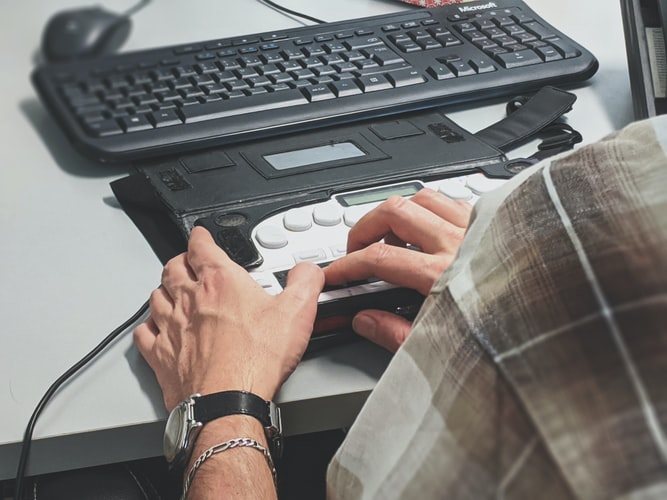Visual digital accessibility is a privilege. One way to overcome this is by educating ourselves on assistive technology, accessible designs and how technology is focusing on digital inclusion.
What is the first thing that you do when you wake up in the morning? Look at your phone maybe? What if I tell you that is a privilege. Accessibility of any sort is a privilege. You don’t have to think twice, to access something visually. People who are visually impaired or who know people with disabilities, understand digital accessibility in a much personal and better way. Have you come across someone who is visually impaired and uses their computer or smartphone? If not we can help you out to understand the dynamics of it to some extent.
For starters, blindness like any other disability is a spectrum. One can legally be classified as blind but there are variations in degrees of sightedness.
Assistive Technology
Assistive technology (AT) is any form of software or hardware used by a person with disabilities in order to perform functions that might otherwise be difficult or impossible to carry out. It is a broader term for enabling people with disabilities to access technology. According to the World Health Organization (WHO), “One billion people need assistive products today and more than two billion people around the world are expected to need at least one assistive product by 2030.”
However, what does assistive technology for the visually impaired look like? There is a wide variety of assistive technology specific to people who are blind or visually impaired. For those who are blind, some of the main AT are screen readers, braille displays, and speech recognition software.
Let’s explore them further:
Screen Readers:
Screen readers have been in functioning for more than three decades now. The first screen reader dates back to 1986. They are available for use with personal computers running Linux, Windows, and Mac, IOS, Android, and more. It is a program that analyses the layout and content of a website and provides a text to speech translation. With a little tweaking and setting changes, one can alter the playback speed. A visually impaired person can skim through the website just as any other person, with the help of screen readers.
Designers take note: Use proper header tags while coding your website for making your website accessible.
Built-in examples of screen readers
- Apple’s iOS VoiceOver
- Android TalkBack
- Kindle Text-To-Speech
Braille Display:
A refreshable Braille display is an electro-mechanical device for displaying Braille characters, usually by means of raising dots through holes in a flat surface. It is basically a flat keyboard-like device that translates text into braille.
Examples of braille displays
- Focus (Freedom Scientific)
- Brailliant (Humanware)
Software that supports braille
- iBrailler Notes
- Google Braille Back
Speech Recognition Software:
These are some of the softwares that can be used
- Apple Dictation
- Siri
- Windows 10 Speech Recognition
- Dragon Anywhere by Nuance
- Google Docs voice typing for dictating in Google Docs
- Gboard for a free mobile dictation app
Visual Accessibility
If you have not looked at visual accessibility yet, now it is high time that you direct your focus there. An excerpt from The Guardian from 2019 – “A class-action lawsuit claims that Beyoncé’s official website violates the Americans With Disabilities Act (1990) by denying visually impaired users equal access to its products and services, according to the Hollywood Reporter. Web accessibility requires photos to be coded with alt-text so that screen-readers used by visually impaired users can speak the alternative text…” There have been high-profile action lawsuits in the past regarding accessibility.
Some of the recommendations that are placed are:
- proper usage of alt text
- Proper heading and labelling
- Avoiding cluttered pages and carousels
- Setting reading focus in accordance with the popups
- Keyboard accessibility
Digital accessibility for all
Apple is one of the most renowned and innovative brands out there in the market. Apple pitched its features and products as an extension of limbs in this video. As you might have noticed too, Apple has constantly tried to provide features that are inclusive. From the voice-over feature to accessibility for the colour blind too. Apple is truly a tech company that has looked into the needs of the various sections of society. In macOS High Sierra, converting between braille and text happens automatically so you can only see Grade 2 Braille. There is also the zoom feature that enlarges your screen up to 20 times to clearly see the display.
Sony too has been taking notes of different needs of their various user base. Features that assist visually impaired individuals can be found on the Alpha 7 Interchangeable-lens digital camera series and the Cyber-shot Digital Camera RX series. PlayStation 4 and PlayStation Vita Systems too have accommodations for the visually impaired. The text magnification feature in their TVs and Talkback feature on phones add to their accessibility belt.
Microsoft is attentive to its users and puts efforts into behind new products specifically for visually impaired individuals.Microsoft is developing and investing in programs that help visually impaired and blind kids learn how to code. This program is called Code Jumper. Microsoft has created an app called Seeing AI. Their mission is turning the visual world into an audible experience. They have various research projects too around accessibility.
Amazon, the one-stop destination for online shopping is also committed to developing hardware and software for the visually impaired. One of the most helpful products Amazon developed for people with visual impairments and blindness is the Amazon Echo. Amazon has developed the Fire Tablet and the Kindle too. On the Amazon Fire Tablet, users can download the free BrailleBack App from the Amazon Appstore.
The present is digital. Let us not forget any section of society when we say this. Make digital accessible!

